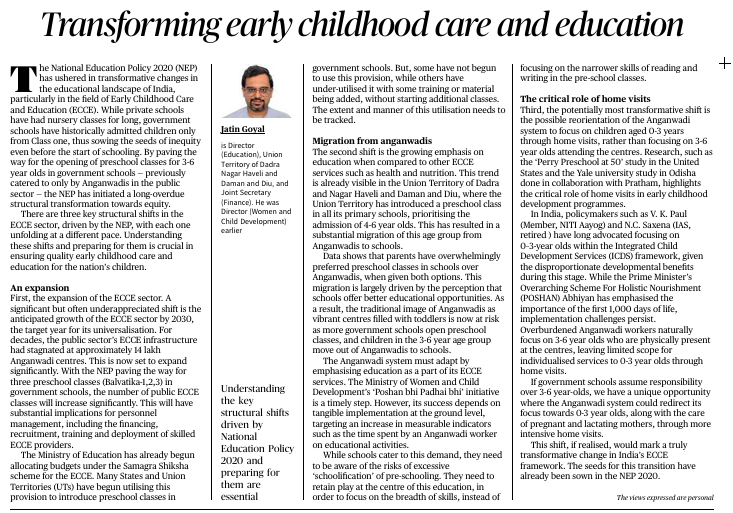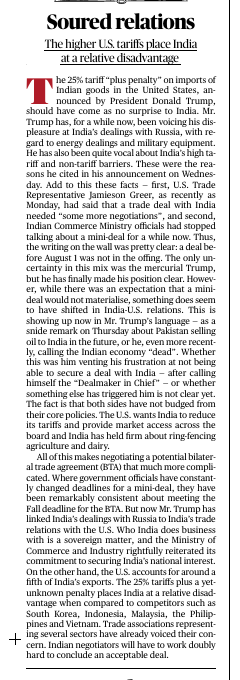Summary – Transforming Early Childhood Care and Education (ECCE)
1. Context
- National Education Policy (NEP) 2020 has brought transformative changes in ECCE.
- Aims to ensure equity in access by opening preschool classes for 3–6-year-olds in government schools, which were earlier limited to Anganwadis.
2. Three Major Structural Shifts in ECCE
a) Expansion of ECCE Sector
- Government schools now admit children from nursery, bridging the equity gap with private schools.
- Target: Universal access to quality ECCE by 2030.
- Challenges: Infrastructure readiness, teacher training, and resource allocation.
b) Migration from Anganwadis to Schools
- Parents prefer preschool classes in schools due to:
- Perceived better education quality.
- Better facilities and opportunities.
- Perceived better education quality.
- This migration raises concerns about:
- Declining enrolment in Anganwadis.
- Reduced focus on health and nutrition
- Need to balance educational gains with holistic child development.
- Declining enrolment in Anganwadis.
c) Role of Home Visits
- Proposal to reorient Anganwadi system to focus on 0–3 years age group through home visits.
- Research shows high developmental benefits from early interventions.
- Models like Perry Preschool Study and Yale University studies highlight long-term gains.
3. Key Concerns
- Risk of overemphasis on academic readiness over holistic development.
- Need to integrate health, nutrition, and early learning rather than narrow focus on reading/writing.
- Importance of tracking utilisation of government school provisions and avoiding exclusion.
4. Way Forward
- ECCE expansion should be holistic, addressing nutrition, health, and learning
- Ensure smooth coordination between Anganwadis and schools.
- Strengthen home-based interventions for 0–3 age group.
- Avoid neglecting underprivileged children during structural transitions.
UPSC Mains Practice Question
GS Paper 2 – Education, Social Sector Development
“Discuss the transformative changes introduced by the National Education Policy 2020 in early childhood care and education. How can India balance the goals of equity, quality, and holistic development in this sector?”
Summary – Soured Relations: US Tariffs and India’s Disadvantage
1. Context
- President Donald Trump imposed a 25% “plus penalty” tariff on Indian goods to the U.S.
- The move reflects U.S. dissatisfaction with India’s dealings with Russia (energy and military) and other trade frictions.
- Adds to an already strained relationship marked by high tariffs, non-tariff barriers, and stalled trade talks.
2. Reasons Behind the Move
- US trade frustration:
- India’s reluctance to cut tariffs across the board.
- India’s selective protection of agriculture and dairy.
- India’s reluctance to cut tariffs across the board.
- Stalled negotiations:
- US wanted broader market access, India wanted ring-fencing of sensitive sectors.
- Mini-deal talks had been halted.
- US wanted broader market access, India wanted ring-fencing of sensitive sectors.
- Geopolitical factors:
- US displeasure at India’s continued oil imports from Russia despite sanctions.
- Trump’s unpredictable diplomatic style and linking of unrelated issues.
- US displeasure at India’s continued oil imports from Russia despite sanctions.
3. Impact on India
- Economic:
- Tariffs make Indian exports less competitive in the U.S. market.
- Potential loss for sectors like engineering goods, textiles, agriculture.
- Tariffs make Indian exports less competitive in the U.S. market.
- Strategic:
- Strains Indo–US relations at a time when cooperation is needed in the Indo-Pacific.
- Could push India towards diversifying trade partners.
- Strains Indo–US relations at a time when cooperation is needed in the Indo-Pacific.
- Negotiation leverage:
- US using tariffs as pressure to secure broader trade concessions.
- US using tariffs as pressure to secure broader trade concessions.
4. India’s Position
- Maintains a consistent stand on protecting national interests in sensitive sectors.
- Willing to engage in trade talks but unwilling to concede on agriculture and dairy tariffs.
- Aims to balance strategic autonomy with economic engagement.
5. Way Forward
- Need for balanced trade diplomacy to avoid escalation.
- Possibility of negotiating a comprehensive Bilateral Trade Agreement (BTA) that addresses both countries’ concerns.
- Diversification of export markets to reduce vulnerability to US trade actions.
UPSC Mains Practice Question
GS Paper 2 – International Relations
“Examine the impact of US tariff measures on India’s trade and strategic relations. How should India balance national interest with the need to deepen trade ties with the United States?”



